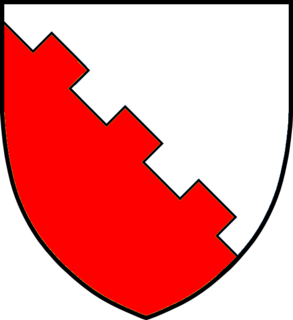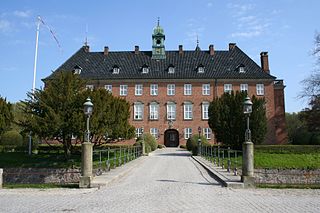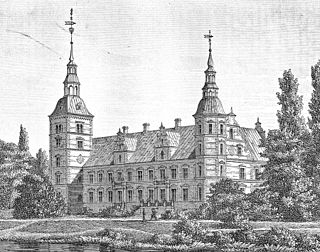
Reventlow is the name of a Holstein and Mecklenburg Dano-German noble family, which belongs to the Equites Originarii Schleswig-Holstein. Alternate spellings include Revetlo, Reventlo, Reventlau, Reventlou, Reventlow, Refendtlof and Reffentloff.

Christian Ditlev Frederik, Count of Reventlow was a Danish statesman and reformer, the son of Privy Councillor Christian Ditlev Reventlow (1710–1775) by his first wife, baroness Johanne Sophie Frederikke von Bothmer. His influence on the life of the Danish people and, particularly, the conditions of the peasantry, made him very popular. He was the brother of Johan Ludvig Reventlow which in the late 1700s served as his colleague, of salonist Louise Stolberg, who was his intellectual partner and opponent through their extensive mail correspondence, and of Commodore Conrad Georg Reventlow.

Halsted Priory, formerly a small Benedictine house, is a manor house and estate located close to Nakskov on the island of Lolland in southeastern Denmark. The estate was renamed Juellinge when the Barony of Juellinge was restored for Jens Juel-Vind in 1721, but its old name was restored when the barony was dissolved in 1921. Holsted Priory is still owned by the Krag-Juel-Vind-Frijs family. The Neo-Gothic main building is from 1847-49. It is flanked by Halsted Church to the north and the old main building from 1591 to the south. The old main building has been renovated with support from Realdania and is now operated as a local cultural centre. The Baroque-style park covers approximately 6.5 hectares of land. The estate is also home to a golf club.

Gammel Holtegaard is a former Manor house in Rudersdal Municipality north of Copenhagen, Denmark, today operated as an arts centre and a museum. It was built by the Danish Baroque architect Lauritz de Thurah (1706–1759), for his own use in 1757. Its original Baroque gardens were reconstructed in 2003.

Vemmetofte Convent is a former manor house in Faxe Municipality south of Copenhagen, Denmark. It was turned into a convent by Princess Sophia Hedwig of Denmark in 1735. Since 1975 it has provided housing available to the general public.

Farumgård is a former manor house overlooking Farum Lake at Farum, Furesø Municipality, in the north-western outskirts of Copenhagen, Denmark. It is located just east of Farum Church and the original Farum village. The land has been sold off and redeveloped, except for the 6 hectares park which is laid out in the Baroque style.
The Suhr family is a Danish family whose earliest member is Bernt Suhr who came to Denmark from Germany in the service of Duke Frederick in 1648. Many early family members were priests or merchants. Johan Peter Suhr founded J.P. Suhr & Søn, a trading house which existed from 1749 to 1897.His grandson Johannes Theodorus Suhr founded the Suhr Family Trust. It owns the Suhr House in Copenhagen as well as the manor houses Bonderup at Holbæk.
Tersløsegaard is a manor house located close to Dianalund, Sorø Municipality some 60 kilometres southwest of Copenhagen, Denmark. It was owned by Ludvig Holberg from 1745 to 1756. He left it to Sorø Academy and it has now been converted into a self-owning foundation and contains a Holberg exhibition. The main building is listed. The main building was listed on the Danish registry of protected buildings and places by the Danish Heritage Agency on in 1918.
Aastrup is a manor house and estate in Elverdamsdalen, between Tølløse and Hvalsø, Lejre Municipality, some 40 kilometres west of Copenhagen, Denmark.
Sonnerupgaard is a manor house and estate in Lejre Municipality, Denmark.
Lungholm is a manor house and estate located on the island of Lolland in southeastern Denmark. It has been owned by members of the Lehn family since 1784. The three-winged main building was listed on the Danish registry of protected buildings and places in 1988. It consists of a main wing from 1856 and two side wings from the 16th or early 17th century.

Orebygaard is a manor house and estate located on Lolland in southeastern Denmark. The current main building, a Neo-Renaissance style building with two towers, is from 1872–1874. It was listed on the Danish registry of protected buildings and places in 1985.
Merløsegaard is a manor house located 9 kilometres north of Ringsted, close to the village of Store Merløse, Holbæk Municipality, some sixty kilometres southwest of Copenhagen, Denmark. Merløsegaard and nearby Bonderup are owned by Den Suhrske Stiftelse. The buildings are now operated as a hotel and event venue.

Tybjerggaard is a manor house and estate in the parish of Tybjerg, Næstved Municipality, approximately 80 km southwest of Copenhagen, Denmark. The Rococo-style main building was built for Tyge Rothe in 1653. It was listed on the Danish registry of protected buildings and places in 1918. The estate covers 475 hectares of land.
Mørup is a manor house and estate located close to Sorø, Denmark. It is now owned by Sorø Academy The half-timbered main building dates from the beginning of the 19th century.

Adam Christopher (von) Knuth was the first Count of Knuthenborg. He established the manor of Knuthenlund. He was married twice, first to Hedevig Ulrikke Luxdorph and second time to Ida Margrethe von Reventlow.
Sørup is a manor house and estate located 6 kilometres south of Ringsted, Denmark. The current Historicist main building was constructed after a fire in 1909. It is now operated as a hotel and conference centre.

Frederiksdal is a manor house and estate located 10 km northwest of Nakskovm on Lolland, in southeastern Denmark. The estate covers 538 of land. It is known for its fortified cherry wine.

Øbjerggaard is a manor house and estate situated east of Køng, midway between Næstved and Vordingborg some 90 km (56 mi) south of Copenhagen, Denmark. One of 12 new manors created when Vordingborg Cavalry District was dissolved in 1774, it was initially the site of a textile factory established by Niels Ryberg. The current main building from the 1840s is now known as Ny Øbjerggaard. The old headquarters of the textile factory, Gammel Øbjerggaard, constructed by Ruberg in 1780 and listed on the Danish registry of protected buildings and places in 1945, is now home to Køng Museum. The current owner of the estate, Peter Eriksen Oxholm Tillisch, resides at Rosenfeldt, his other estate, while Ny Øbjerggaard is operated as a bed and breakfast.












